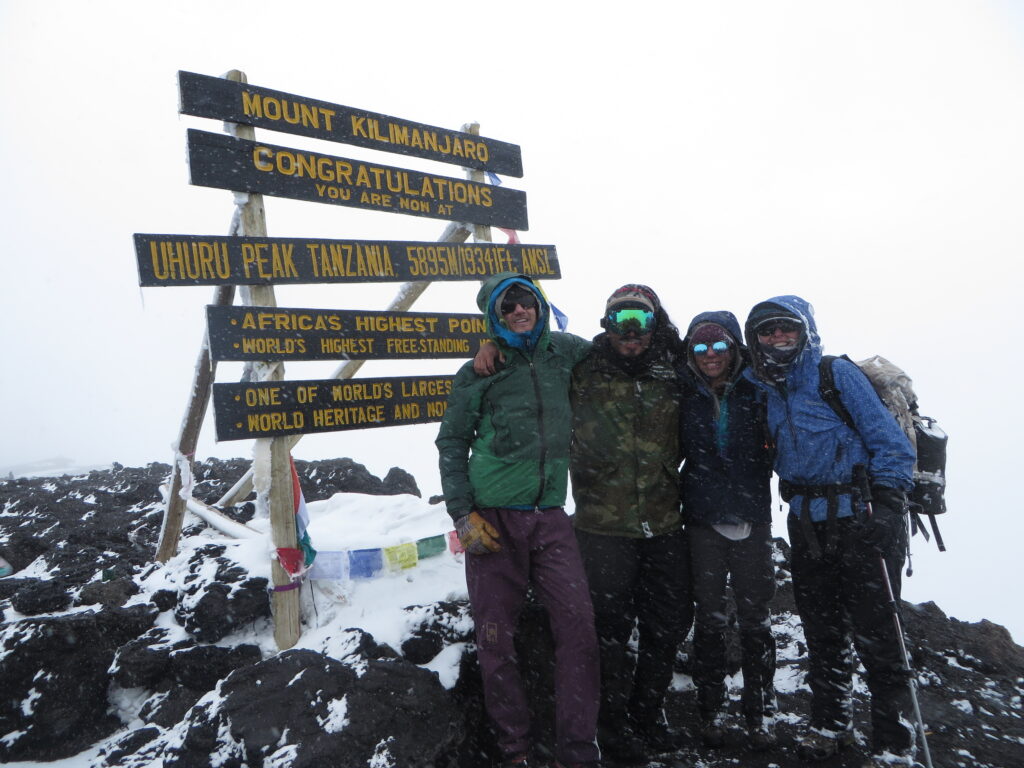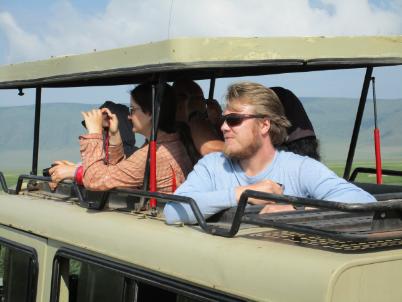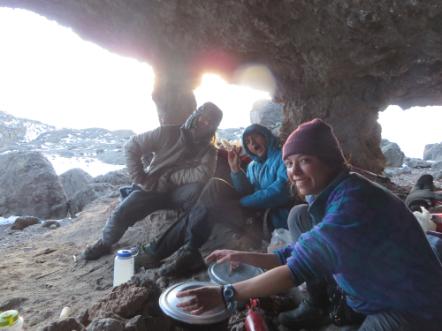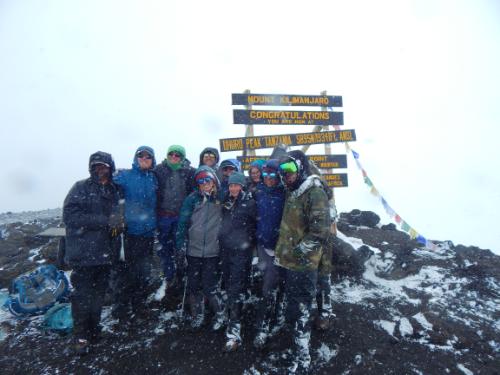Home / News / Past News / Fall 2018 News / CWC STUDENT RESEARCH TEAM JOINED OTHER STUDENTS FROM AROUND THE NATION TO TRAVEL TO EAST AFRICA
CWC STUDENT RESEARCH TEAM JOINED OTHER STUDENTS FROM AROUND THE NATION TO TRAVEL TO EAST AFRICA
Home / News / Past News / Fall 2018 News / CWC STUDENT RESEARCH TEAM JOINED OTHER STUDENTS FROM AROUND THE NATION TO TRAVEL TO EAST AFRICA
CWC STUDENT RESEARCH TEAM JOINED OTHER STUDENTS FROM AROUND THE NATION TO TRAVEL TO EAST AFRICA

As part of a science-based NOLS course offered in partnership between Central Wyoming College, the University of Wyoming and NOLS, nine students from around the country traveled to East Africa for a 28-day scientific adventure that started in early January. Of the nine students, five are CWC students; Aaron Strubhar, Tobias Osborne, Bailey Lewis, Gabriel Spoonhunter and John McCormick.
All five have traveled different paths to get to this point of conducting field-based scientific research and summiting Africa’s highest peak.
Strubhar, Osborne and Lewis started their experience in scientific research through CWC’s Interdisciplinary Climate Change Expedition. Strubhar and Osborne are also graduates of CWC’s outdoor education and leadership program, who said the program provided them with a strong foundation in wilderness risk management and backcountry leadership, as well as wilderness travel skills.
“I was unsure what I was getting myself into when I moved to Lander to be a part of the outdoor education and leadership program at CWC,” Strubhar said. “It turned out to be one of the best decisions of my life. The instructors and professors here facilitate such amazing research expeditions that give us a chance to use the skills we are acquiring through our courses in the field. This will be my fourth expedition with CWC and my first international expedition. This expedition to Tanzania will truly be a great culmination of all the hard work my fellow students and me have put in at CWC.”
Osborne said he hopes to apply the skills he has gained through his studies in outdoor education and leadership, and through CWC’s Alpine Science Institute to better understand how humans can do a good turn for the environment.
“If you want to learn about the planet, there is no better place to start than learning about yourself, and learning about the techniques you need to understand the science of the planet, and the role humans play in making the planet habitable,” Osborne said. “ICCE and my NOLS course in Patagonia helped give me the experience, the confidence and the desire to want to travel to Tanzania to pursue more scientific research.”

Lewis has been an archaeology and geographic information systems student at CWC for the past two years and will graduate in December. During the summer semester Lewis honed her skills in field-based geospatial data collection and digital mapping through CWC’s archaeology field school, and through participation in high elevation glacier studies and alpine archaeology work through CWC’s ICCE.
“I never imagined that my education could lead to incredible opportunities like I’ve been offered at CWC,” Lewis said. “The staff and my fellow students have created a supportive learning environment that has created life-long friendships. I have participated in two expeditions and an archaeological field school through CWC. Each experience has been a stepping stone in my career as a scientist.”
Expedition participant Spoonhunter has taken several different courses with NOLS and is a tribal field crew leader for the Montana Conservation Crew. Spoonhunter has a good deal of field experience and led an all Native American work crew this past summer. Spoonhunter is a dual major in both outdoor education and leadership and expedition science at CWC.

“It will be an amazing experience and opportunity to leave the country, especially for scientific research,” Spoonhunter said.
Many Native Americans should look for these educational opportunities to travel internationally. There was a time when our people couldn't, and our ancestors fought for the rights we have today. It doesn't matter about someone else's opinion if you really want to see the world; do it for you. ”
Gabriel Spoonhunter
Spoonhunter who is Northern Arapaho and Oglala Lakota said he hopes to inspire others.
“Never let people tell you can’t do something that will better you,” Spoonhunter said. “Visiting African Indigenous tribes and maybe summiting Mt Kilimanjaro will be amazing.”
Preparation for this expedition was a lengthy process for the team. Students crafted detailed research applications, wrote grants to help fund their trip and sought scholarships to help defray costs. These tasks alone kept the students busy for much of fall. Several of the students were successful in receiving travel and scholarship support from NOLS and from the National Science Foundation through a program called COWYAMP that is designed to increase the number of students involved in scientific research.

“Why should our students not reach as high and strive to go as far as any other students from other institutions across the nation?” said Jacki Klancher, CWC faculty mentor and Director of Instruction and Research at CWC’s Alpine Science Institute. “With tremendous input and support from NOLS, the CWC Foundation, CWC’s Diversity Coordinator, Ivan Posey and the administration at Central Wyoming College, we are taking these students to places they never imagined they could go, both literally and figuratively. This expedition arose from an enthusiastic and complex partnership across several institutions.”
Klancher said that having Dr. Sarah Konrad, an experienced mountaineer end glaciologist from UW, as co-leader for the scientific research, and having some of NOLS most senior instructors on deck to lead the course in East Africa made this a well-staffed expedition. Both Konrad and Klancher are former field instructors for NOLS. The team leader on Kilimanjaro will be senior NOLS instructor James Kagambe.

This East African expedition was similar to the outdoor skills and leadership course offered by NOLS. The expedition required students to develop a scientific research project and implement their plan on the flanks of Mt. Kilimanjaro, East Africa’s highest peak. Participants on this course spent several days at more than 17,000 feet to learn about research methods in glaciology and apply them to the high elevation glaciers of Mt. Kilimanjaro. As students ascended and descended the mountain, they learned and applied scientific methodologies associated with learning more about plant morphology and microbiology. They collected data about the changes they observed across climatic life zones on Mt. Kilimanjaro.
“It is a powerful feeling standing on a glacier and knowing that this ice will melt and travel downstream. Giving life to those that need it and we all need it,” Strubhar said.
The CWC students are planning to do a public presentation on their expedition.

2660 Peck Avenue
Riverton, WY 82501
(307) 855 – 2000
Campus Map
120 Enterprise Blvd.
Lander, WY 82520
(307) 332 – 3394
Campus Map
240 S. Glenwood St #124
P.O. Box 4795
Jackson, WY 83001
(307) 733 – 7425
Campus Map
302 W. Ramshorn
P.O. Box 175
Dubois, WY 82513
(307) 455 – 2625
Campus Map
© 2024 Central Wyoming College – All Rights Reserved